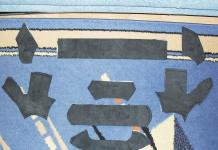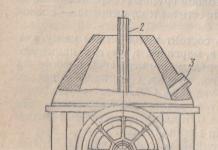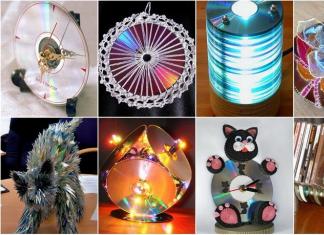
DIY carpet made from old things
Before starting work, we need to prepare the “yarn”. Knitwear (T-shirts, T-shirts, blouses) is best suited for knitting rugs. It will be great if things turn out to be bright and natural, then your DIY rugs will be rich and pleasant to the touch. Spread the prepared item on a flat surface.
Cut off the bottom finishing seam.
Then we cut a strip 2-3 cm wide from one seam of the product to the opposite one. Before cutting 3 cm to the second seam, we stop.
And with such strips we cut all the fabric up to the armhole line.
As a result, we get one whole tape. In this way you can cut any thing, even children's tights. Please note that the width of the tape depends on the thickness of the fabric you are cutting. The thicker the fabric, the narrower the ribbons should be.
The remaining part of the item can be cut in a spiral. Round the right corners on the spiral tape. Tie or sew the resulting ribbons of different lengths. Using the “spiral” method, you can cut the smallest scraps and tissue remnants.
We wind the resulting ribbons into balls and take the next thing. It is better to wind ribbons of different colors into different balls, so when knitting it will be more convenient to select the color. The more multi-colored balls you get, the more interesting it is to work and the more fun the rugs will be. New life for old things: 10 witty ideas.
DIY knitted carpets
Even a beginner knitter can handle knitting a rug. We will need a hook (from No. 7 and larger) and your balls. Before you make your own knitted rugs, decide where you will place the rug. Then it will be easy to calculate the required size and choose the color scheme.
We collect the required number of air loops - this is the width of the future rug. And we knit the rug in the simplest way - single crochet. Knit the first rectangular rug - this one is easy to knit. Let the next one be round. To do this, connect 5 air loops into a ring and then knit in a circle, not forgetting to add loops.
DIY carpet made from yarn
Nice rugs are made if you make 2-3 rows of the same color, then change to another color and return to the first one. It all depends only on your imagination and the availability of multi-colored material. I really like the finishing touch to the whole piece. The advantage of this method is that you can knit a rug that fits perfectly!
Weaving
To weave a rug, you will need a frame (a photo frame will do). You can make it yourself in dimensions of 30 by 45 cm with rows of nails with small smooth heads stuffed along the long sides. The distance between the nails is 2.5 cm.
We stretch the warp threads onto the nails in pairs. The base can be a neutral color. If you pull the rows tightly together, it will not be visible at all. If you weave loosely, then keep in mind that it will be visible.
Now take the working thread and begin to pass it either under the warp thread or above it.
When the first row ends, pass the thread through the last warp thread and point it in the opposite direction. At your discretion, make the desired number of rows.
When you decide to change the color of the working thread, simply cut and tie the end with a thread of a different color. If you want to make a rug with fringe, connect the ends of working threads of different colors, leaving “tails”.
Periodically pull the woven rows towards the very first row. Place all knots and seams on the wrong side and carefully remove the item from the frame.
The rug is ready! Add some fun ponytails and try them on!
These are just a few options on how to make a carpet with your own hands. They seem to me the simplest and most entertaining. The kind that you can do even with children.
What is "Hand Made"? This is a banal, ordinary handicraft, English transcription, new, fashionable, modern sound. After the term came into use, interest in this activity increased.
Handmade hobby - is it boring or fun?
Previously, in Rus', only girls from noble families could afford to embroider a handkerchief in their spare time. They did it for fun and in order to show their best side, to demonstrate their meekness of character.

The peasants did not particularly use handkerchiefs; they saved fabric. It was necessary to use a spindle to create cloth, sew clothes, curtains, bed linen, tablecloths, embroider all this for yourself, your family, home, comfort. Also prepare fabric and threads for the gentlemen’s young ladies.

Nowadays, each person diversifies his leisure time at his own discretion. Buying fabric is not a problem. Scraps, ribbons, woolen, linen threads, beads, beads, rhinestones, lace help to put the most daring ideas into practice.

It is fashionable to make your own clothes, accessories, and a variety of decorations for the interior of the room. Notebooks, carpets, dolls, paintings can be made if desired. handmade is a fascinating hobby that everyone can afford. Handicraft is still considered something boring and tedious.

Why handmade carpets?
Christian Dior once seriously wanted to start making carpets. This art captivated him, but in the end he chose clothes. It happened that way. Despite the fact that the meter abandoned this idea, to this day designers treat handmade carpets with particular respect.

On a sunny morning, throwing the blanket aside and walking barefoot on a soft, luxurious carpet that gives bliss is certainly pleasant.






The interior and comfort in the house are a source of self-sufficiency. It happens that the area of the apartment is small. How to buy an apartment? It's a difficult question. Not everyone and not at any age can afford to buy a spacious apartment. In this regard, melancholy can creep into the soul and settle in the heart.

The flow of self-love in the river of self-sufficiency will be blocked either by a bump or a stone of unwanted circumstances. This can only be changed if you create a good interior design. In this case, when you come home, you can rest and relax. The nervous system will be restored, the mood will improve, irritability, anger, and quarrels will disappear.

A compromise will be found at the right time, discussion, dialogue will help improve relationships with colleagues. Perhaps loneliness will disappear, a friend, a loved one will suddenly appear.

A DIY carpet is a great start, the first step on the path to success. The room will be different. It can be made either from specially purchased materials or from unnecessary scraps.

Suitable manufacturing technique
By looking at photos of a do-it-yourself rug and examples, you can get a lot of ideas. Rugs can be very different. There are not so many techniques for creating them.

Having chosen the best, optimally suitable one, concentrated on creativity, tuned in to success and luck, you should get to work. There are no unnecessary doubts. You can even make a rug in one day.

Carpets are:
- woven;
- sewn;
- wicker - from rope or from shreds;
- crocheted or knitted - with or without a fabric base;
- made from softwoods, pebbles and other materials that evoke sympathy.






A woven rug is created using special tools. This method is many centuries old. If spending on tools is not included in your plans, you should use everything that is at hand. This is the basic principle of handmade.

Sewn rugs involve the use of any fabric. If you have a lot of T-shirts and jeans lying around the house, you can cut them up, turn them into appliqués, sew them onto a base, or use padding polyester.

It’s easy to turn the same T-shirts, sweaters, paitas, blouses into filler, crushing them to the size of confetti, a little larger than dust - the threads of the main fabric should hold them.

You will have to divide the base into cubes and triangles so that the filler does not roll off and is distributed harmoniously. After all this is done, you need to sew on a canvas with a pattern.

Cubes and diamonds sometimes get in the way and deform the drawing. It is more rational not to turn the carpet into a blanket, but to use several layers of fabric or thin, smooth, even padding polyester.

From appliqués and scraps alone, you can create a fluffy, openwork rug if desired. It will be less durable. Perhaps it will be characterized by asymmetry. But is that bad? The main thing is that this rug matches the interior design and its style.

Braided ones from scraps or rope are more difficult to create. You need to know how to tie knots. An example diagram will be useful. Once you get the hang of it and figure it out through trial and error, it will be easy to draw your own diagram. But it’s unlikely that you’ll be able to draw it right away.

The easiest way to master the art of weaving carpets from scraps and rope is through practice. The scheme can be scary. Sometimes they look at her for a long time, not daring to start. You need audacity, optimism comes in handy. For some people, this particular technique is immediately easy for them and becomes their favorite. Handmade helps to reveal talents and teaches you to be surprised at yourself.






How to make a rug with your own hands if you have yarn, a hook or knitting needles? It couldn't be simpler. But the process of creating it will take quite a lot of time.

The patterns will help you master this skill and learn how to knit the desired shape. Pom poms will come in handy. They can be used to make a carpet faster.

Unusual materials are often chosen for a handmade carpet. Everything that is at hand is used - at your own discretion, to your taste. The main thing is that in the end the carpet is not slippery.

A room or apartment should be made to feel comfortable. This is true self-care. It is important to rest after a busy day, get enough sleep, warm up in the winter cold, and devote a little time every day to yourself.

This can be done if there is a personal space created with the help of a screen or with the help of color, craftsmanship, talent, hand-made products.

DIY rug photo






















Spring is the time for general cleaning. Therefore, we should look into our closets and go through everything to get rid of the old things stored there. But don’t rush to get rid of it for good, because everything has the right to a second life. For example, you can create rugs from old things with your own hands and give yourself new emotions and memories.
Rugs made from old things, what techniques can be used
Old things are an excellent material for creativity, which a thrifty housewife can always find. T-shirts, unusable towels, and any wardrobe items can always get a second life. But it is still very important to understand that in order to create new things from old ones, it is necessary to pay attention not only to the material for creativity, but also to the technique that we choose for this.
After all, rugs from old things can be:
- weave,
- to tie,
- sew.
And we will try to create a rug from old things with our own hands step by step, using detailed master classes and getting an excellent result.
Weaving
One of the oldest and most proven techniques for creating carpets is weaving. After all, this does not require a lot of knowledge or skills. And sometimes the simplest tools are required, easily replaced with something that is always at hand. And therefore, it’s worth starting to create your first rug with weaving or weaving.
Weaving according to the principle of macrame
If you think that macrame is only suitable for creating small elements, then now we will dispel this belief. After all, if instead of a thin lace you take something more voluminous and dense, then the result will be completely different.
There are no difficulties or tricks in weaving rugs from old things that are inaccessible to novice craftswomen. As in any technique, the main role here is played by the sense of taste and the desire to create. Therefore, any set of old clothes can easily be turned into a charming bedside rug with a little effort.
Basic knots and pattern combinations are great for weaving. But it is worth considering several factors:
- The rug is used actively and therefore needs to be washed from time to time,
- they will not only trample on it, but can sit, lie or use it as a bedding on a chair,
- it must fit into the overall interior.
That is why when choosing knots, do not forget that the rug should:
- look like a new, not well-worn rug,
- have a dense structure so as not to crumble in your hands and not turn into a string bag,
- not be easily soiled or bulky, for ease of cleaning.
And therefore the most common way of weaving at present is to use the principle of knitting with a French bracelet.

Such a charming rug will definitely not go unnoticed in the house and will highlight the interior and taste of the owner. And to create it you won’t need much:
- wide strips of old things,
- adhesive tape,
- scissors,
- thread and needle.
To begin, arrange the 5 strips in the order you like best. Next, fold 5 more strips, but in a mirror image.
It is most convenient to fasten all the ends from the beginning side with adhesive tape. This will allow you not to be distracted during the weaving process, and also clearly define the sequence.
So, when all the ribbons are laid out, we take the leftmost one, take it to the side and fold it so that it lies on top of all the others, creating the number “4”. We place the working tape behind the adjacent one and tie the first knot.

We continue to tie the same knots on the next 3 ribbons, and then move to the opposite side, starting to weave towards the first series of knots.

When both working strips meet in the middle, tie them and continue weaving from the edge. Once you've reached your desired length, simply tie the last knots with a strong thread and trim off the rest to create a cute fringe.
Don't forget that you don't have to twist the braid, you can fold it like a snake or lay it parallel to one another to get a charming rectangular rug with fringe.

Knitting rugs from old things
It is not necessary to weave rugs from old things; knitting is considered a more common solution for creating them.

Even if this is your first time picking up a hook, you will be able to create a charming and practical decorative element. After all, it is the large knitting that will help you quickly understand the intricacies of crocheting. And a pattern made from the simplest single crochets can look very bright and original if you choose the right yarn.
Moreover, yarn is also made from old things. This is how things can go:
- old T-shirts,
- jeans belts,
- just thin strips of fabric left over after sewing outfits.
It is enough to know and be able to knit increases, and then it’s a matter of technique.
If the yarn taken for the rug seems loose or thin to you, you can use an excellent trick - at the beginning of knitting, insert a strong cord into the stitches and continue tying it. This way your spiral will keep its shape perfectly.
To get a more openwork rug, knit with double crochets, increasing their number in each row. But keep in mind that although such knitting will be beautiful, it will be less dense.

Openwork rug

It is worth noting that you can knit a rug from old things without a hook - an interesting technique of knitting from rings on your fingers will help you cope with the disposal of small pieces without spending extra effort and without forcing you to buy any special tools.
You can learn how to knit from rings from Olga Popsueva. In her video master class, she explains in detail how to weave a braid and then form it into a rug.
Patchwork
When talking about using old things to create rugs, it is difficult to ignore sewing. After all, they started a long time ago and independently of each other in different countries.

As now, women did not throw away old things, children's dresses or their husband's worn-out shirts, preferring to collect them so that they could then sew bedspreads, curtains and, of course, rugs. It’s no longer a shame to trample such rags, cut them and assemble them into various intricate patterns.
Fluffy rugs on mesh
In the last few years, fluffy rugs have become very popular, making it so much fun for children to play and crawl in them. And it’s just nice to immerse your feet.

The high pile and soft texture have won the hearts of craftswomen and housewives, and the bright colors attract the attention of household members. But what’s most pleasing is the fact that you can make such a rug without using any special tools.
A fluffy rug can be created in different ways:
- tying the cuts in knots,
- using a carpet hook,
- using the simplest crochet hook.
Our basis will be a mesh from a hardware store with a large mesh or a bath mat with holes.

In addition to the basics, we also need:
- fabric ribbons,
- scissors,
- hook (optional).
To begin with, cut short ribbons, but do not skimp on their length, because you need to take into account that they will be folded in half, and even tied or otherwise fixed to the mesh. Therefore, it is better to make them longer, and then cut them as you want.
When everything is ready, you will be left with the most important task - thread the strip of fabric into the cell so that both ends remain on the front side, and then you can tie them together with a simple knot, or pass them through a loop using a hook.
When the flaps completely cover the mesh, all you have to do is cut them to the desired length and the rug made from old things is ready to delight you and your feet.
Fluffy rugs using a sewing machine
If you don’t want to waste your time tying each individual ribbon, or you haven’t found a suitable mesh, then you can go in a simpler way, for which we will need:
- an old pillowcase or piece of fabric that will become the base,
- all the same ribbons from old things,
- scissors,
- sewing machine.
Knitwear is best suited for such rugs, as it is more elastic and soft. In addition, it is easy to sew on without fear of breaking the needle.

Bright carpet made from old knitwear

Heart shaped rug
After you cut the required number of ribbons, pull them lengthwise so that they curl a little, and then simply apply them to our base and sew them in the middle, row by row.
Don’t worry if the strip doesn’t lie flat, you can always trim the entire pile, leveling it to the desired length.
Rugs made from old things, what will be used?
We learned about techniques for creating a rug from old things, now it’s worth talking about what can serve as material for them and how best to bring your idea to life.
Taking into account the density, quality and size of the old item, you can choose the method of its transformation. That is why we would like to tell you a little about how and what rugs are made from by modern needlewomen.
Rugs made from old jeans
The first thing that comes to mind that requires regular disposal is jeans. Denim has long conquered our hearts and there is not a single fashionista or fashionista who does not have jeans in her wardrobe. Moreover, despite their strength and versatility, they still wear out, stretch, or otherwise become unusable.
Of course, it’s a shame to throw them away, so we collect them on a separate shelf so that we can sew something later.
But sewing requires patterns, a sewing machine, and sometimes also space. While making a rug from old jeans with your own hands will not be difficult at all - everything from the canvas to the pockets and belt will be used.
Just choose a technique and select flaps for it:
- cut them into long strips and weave a rug on a loom,
- weave long braids and gather them into a round rug,

- arm yourself with a large hook and knit any shape using cut strips instead of yarn,
- weave the strips together using the braiding principle and sew on a machine or by hand.


And the cat liked it)
Considering the strength of the material, such a rug will serve you for more than one season.
Rugs made from old T-shirts
But we wear out T-shirts more often than jeans. After all, we use them every day, grow out of them, stretch them, get dirty with paint and simply get tired of them over time.
You may not be able to wear them anymore, but the knitwear used to make T-shirts can be an excellent material for creativity. They make great potholders, coasters, bags and, of course, rugs.
How to make knitting yarn with your own hands
When we look at these DIY rugs made from old T-shirts, at first we can't believe what they're made of! After all, craftswomen knit with crochet from something very similar to yarn, and not like an old T-shirt.

However, do not be surprised by this and do not think that there is some kind of trick here. Anyone can turn old T-shirts into knitting yarn.
To do this, just follow the detailed video master class on the Utilitarian Crafts channel, in which they will teach us how to make as much yarn as possible from an old T-shirt for new rugs.
A T-shirt is a universal material for creating your own rug
And after preparing the yarn, you can already try your hand at creating rugs from old T-shirts with your own hands. After all, they can be:
- to tie,
- weave,
- cut for fluffy rugs,
- sew pre-braided braids from them.
And all you need is a couple of T-shirts and a desire to create.

Moreover, any patterns of napkins or lace are suitable for crocheting, and you can weave according to the previously described principle of a French bracelet.
Or take your favorite T-shirts, cut them out and sew a rug together like a quilt so you can preserve memories without throwing anything in the trash.

Rugs made from old tights
The most consumable wardrobe item of all time is tights. They tear and become unusable so quickly, and even have some seasonality, that at some point we all think about whether we should come up with something after they have served their life.
And we found the answer - rugs from nylon tights that you can make with your own hands! After all, they can be an excellent yarn for knitting or weaving a new rug - durable and practical.

The main thing is to know a few tricks:
- to get a long strip from one pair of tights, you just need to cut off the socks and panties, and then cut the remaining tube in a spiral,
- do not tighten the knitting so that the rug made from old tights does not deform and lose its shape over time,
- nylon can be dyed to make your rug brighter - just use fabric dye and follow the instructions on the pack.

You can create rugs from old tights with your own hands and without a hook. They can be:
- sewn from braided braids,

- woven on a loom,

- woven on a hoop.

And children's tights, which are most often collected in our bins, are perfect for knitting on fingers. All you need to do is cut them into rings, and then use the video tutorial from Marina DIY Dolgih:
Rugs made from old towels
And even old towels have a use in the world of rugs. Due to their density, length and ability to absorb moisture well, they can give us an excellent accessory for the bathroom, bathhouse or balcony, where you always need to keep your feet warm and dry.

Making a rug from old towels with your own hands is as easy as any other. It's easy:
- trudges
- fits
- weaves
- curls up.
In general, it is created in such a way and using the technique that lies on your heart.
And if you want to give life to terry towels in this way, then try making a fluffy rug on a construction mesh.



As you can see, when cleaning the house, you should not rush to throw away your used items. Old T-shirts, towels and even tights can inspire you to create something new and no less useful than their original purpose. Just be smart and your home will be filled with new, soft and fashionable rugs that you can create without spending anything but your time and getting a charge of emotions and good mood!
Centuries-old traditions of carpet weaving are passed down from generation to generation by many peoples. Lint-free, smooth carpets are common among the peoples of Russia, Ukraine, and Moldova. Their fabric consists of warp threads in length and weft threads running crosswise. The pattern is obtained from the interweaving of multi-colored threads. You can weave such a product at home.
Instructions
- Pile carpets are made on a colorless base. Multi-colored threads are tied to it in knots, which are then cut at the same height. The quality of a carpet depends on its density, i.e. on the number of nodules per 1 cm2.
- To learn how to weave a simple plain carpet you will need a loom. This simplest structure consists of a base on which a wooden frame is attached. The lower crossbar is fixed motionless, the upper one moves freely in the grooves and is secured with wedges so that the crossbars are strictly parallel. The size of the machine depends on the size of the carpet you want to make. In lint-free carpets, both sides have the same pattern, which is formed by simple weaving - crossing the warp and weft threads in a checkerboard pattern. The warp requires strong twisted threads; they are placed along the length of the carpet and counted in pairs. The weft threads are transversely intertwined with the warp threads and are counted by the number of throws. The carpet pattern is read from a technical drawing, which is divided into conditional cells formed by one pair of warp and a certain number of weft pads. Therefore, the technique of such carpet weaving is called counting.
- Knock the wedges of the top rail out of the grooves so that it drops 2-3 cm. Fill the machine with the base. To evenly distribute the warp thread, make marks on the strip with a pencil. The last warp threads on the sides should not be closer than 10 cm to the sides of the frame. The thread should wrap around the slats strictly vertically. The end of the thread is tied to the lower crossbar, then the thread is thrown over the upper crossbar and returned from under the lower one. The warp threads must be distributed evenly. On the sides of the base, pull two or three additional threads - these are the edges of the carpet so that it does not curl with a roller. They also finish the warp on the bottom rail by tying the end of the thread.
- Drive the wedges into the grooves of the top rail, keeping the base taut. Divide the warp threads of the front working surface into even and odd, lay between them a round strip with a diameter of 25 mm and a length exceeding the width of the warp by 8-10 cm. Count the hem by a pair of threads. The space between the even and odd threads is called the shed. The width of the pharynx should extend across the palm of your hand. Count the hem a pair of threads at a time.
- Divide the rug base into pairs. Make an equalizing braid. Tie the same thread as for the warp with one end to the right side of the loom, then bring it out from back to front, clasp a pair of warp threads and wind it back again to the next pair. The result is loops covering each pair of threads. Secure the end of the braid to the left side of the frame. Make the same braid under the top bar. Make sure that the braid is strictly horizontal.
- In order for the weft threads to intertwine with the warp threads, the position of the warp threads must constantly change. Those. Even pairs must move backwards and odd pairs forward. To do this, you need to change the position of the pharynx. This is convenient to do with the help of healds. Cut the threads into equal lengths of 30-35 cm, wrap a heddle around each odd thread, bring them out, and tie them into a knot every 6-8 healds. Now, by pulling the knot, you can easily change the position of the threads.
- Prepare the yarn for the weft. Wind it into balls, unwind it into small jackets - small skeins in the shape of an eight, which are convenient for laying weft threads inside the shed. The carpet is woven from the bottom up. Place the first row of weft from left to right, securing the end of the thread in the middle. Gently and tightly nail it to the bottom braid with a mallet - a special device that has a wooden handle and slightly rounded 8-10 teeth made of metal plates. On the next weft row - from right to left - lower the healds, changing the position of the even and odd warp threads.
- The principle of weaving is observed throughout the entire production of the carpet. After a few rows, start drawing the carpet according to the diagram. Make sure that the weft threads do not tighten the warp and cover it completely. A pile carpet is knitted on the same machine, but instead of weft threads, multi-colored wool threads are tied into pairs of warps with knots.
You will need
- - frame;
- - stick 20 cm long;
- - woolen threads of different colors;
- - threads for the base;
- - needle;
- - scissors;
- - a piece of cardboard.
Instructions
Prepare materials for a small rug. Make a frame. It is a rectangle, the dimensions of which are slightly larger than the dimensions of the future product. Try to keep the corners strictly straight. The lower bar is rigidly attached to the sidewalls, the upper one is inserted into special grooves. Parallelism is regulated by special wedges. The frame is usually fixed to the bed.
Decide whether you will make a carpet with or without pile. In any case, you need to determine the approximate density of the weave in order to divide the pattern into cells. The best option is 22 knots for every 10 cm for a pile carpet. However, it is better to start with a smooth, simple weave. When making a pattern, it is not individual warp threads that are counted, but pairs. On some machines, the warp threads are pulled onto nails. But quite often they are simply wrapped around the top and bottom bars of the frame. It is better to mark both slats to maintain parallelism.
The thread for the warp should be twisted and strong enough. It can be cotton, linen or synthetic. For a shag carpet, choose a clear backing or one that matches the color of the wool threads. For a lint-free product, undyed cotton or linen are most suitable.
Pull the thread. It must be firmly attached to the bottom bar. Lower the top rail a little. Tie the thread to the bottom rail at a distance of about 10 cm from the sidewall, then draw it strictly vertically, throw it over the top rail and lower it vertically down. Bring the thread from under the bottom bar. Repeat the procedure, finishing forming the base approximately 10 cm before the second side. If you started winding the warp from the bottom, then the thread should end at the bottom.
Between the sidewalls and the outer warp threads, make edges by pulling a few more threads. They are needed to keep your rug from curling.
Choose wool threads by color. Before you start weaving, check whether they shed or not. Of course, you will have to wash the rug infrequently, but this is not excluded. For the first time, it is better to avoid subtle color transitions. Choose bright threads in primary colors. It is better to wind the yarn into balls.
Make a drawing. If you don't know how to draw, find a suitable image on the Internet. It is desirable that this is a picture with large fields, with a small amount of detail. The drawing can be processed in Adobe Photoshop, making it black and white and removing excess. Distribute the color fields. They can be colored with a pencil or felt-tip pen for clarity. Break the pattern into squares. The process is approximately the same as when preparing a design for cross stitch or tapestry. In each cell, 1 pair of warp threads is counted, and cross-weave threads (weft) are counted by the number of spacers.
Using wedges, lift the top bar slightly so that the warp threads are taut. Identify even and odd threads. The distance between them is usually called the pharynx. Place a long round strip between the even and odd threads. It should be slightly larger than the width of the base. For large carpets, a strip with a diameter of about 2.5 cm is used. When making products from thin threads, its function is often performed by a cardboard strip.
Attach the same thread to the right rail as for the base. It is needed to combine pairs of threads. If the carpet is wide, you can roll it into a small ball for convenience. Bring the thread forward, wrap the first pair of warp threads with one turn, bring it to the next pair and wrap it too. Thus, pull the thread to the end. Tie the end to the left side. Do the same on top.
Mark the even pairs. This can be done using short threads. This is necessary so as not to get confused in the process, because when weaving there is an alternation - first a pair of threads is in front of the weft thread, in the next row it will be behind.
Wrap the weft yarn into small balls. It is very convenient to use fairly large shuttles for tatting. Lay the first row from left to right. Pass the thread as in normal weaving, first in front of the pair of warp threads, then behind. Press the row of wefts against the edge, that is, against the thread with which you wrapped the loops. To ensure that the rows lie tightly, a special mallet with several metal teeth is often used. Weave the next row from right to left. Pass the weft thread over the pair of warp threads if it was under it in the previous row, and vice versa.
In lint-free fabrics, the perimeter pattern is usually formed by alternating threads of different colors. But nothing prevents you from making a floral or geometric ornament according to the pattern. Just remember to secure the threads. Weave the main pattern according to the drawing.


























